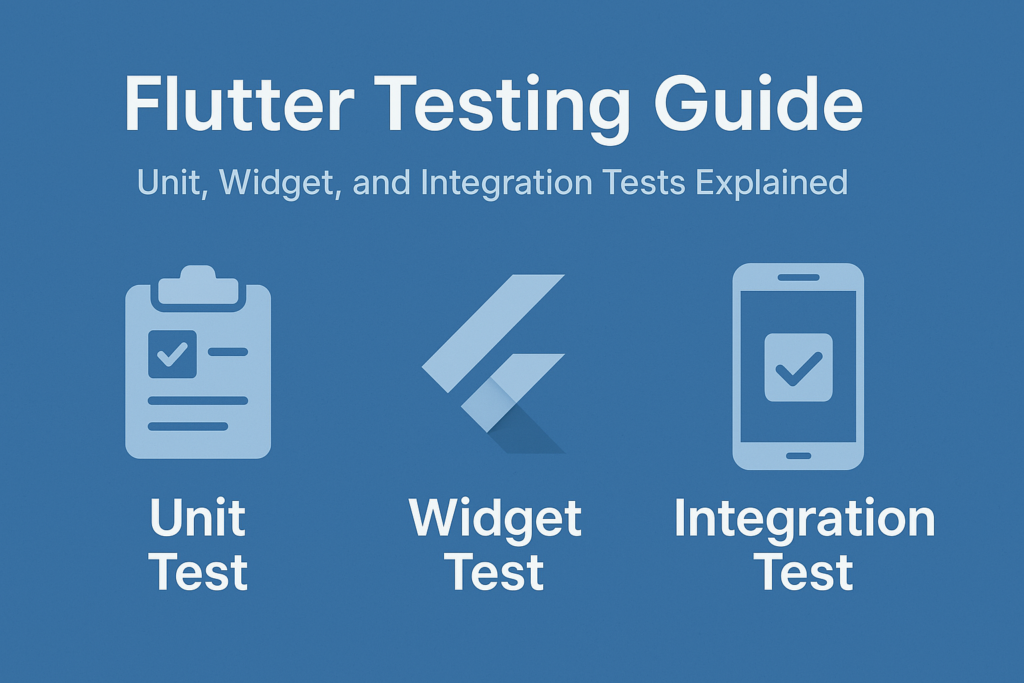
Testing is a key part of writing reliable, maintainable Flutter apps. It helps you catch bugs early, refactor with confidence, and ship faster without breaking things. In this post, you’ll learn about the three main types of testing in Flutter—unit tests, widget tests, and integration tests—and how to use them effectively.
Why Testing Matters in Flutter
Flutter apps can get complex quickly, especially with multiple screens, services, and state management. Without tests, it becomes risky to update your code.
Benefits of testing your Flutter app:
- Catch bugs early
- Validate business logic
- Ensure your UI behaves correctly
- Improve code quality and confidence
- Enable easier refactoring
Testing in Flutter: 3 Types
Flutter supports three levels of testing:
- Unit Tests – For individual functions or classes (no UI involved)
- Widget Tests – For testing widgets and UI interaction
- Integration Tests – For end-to-end app behavior (e.g., login flow)
Each type serves a different purpose, and together they give full test coverage.
Unit Testing in Flutter
Best for: Testing logic-heavy functions or services (e.g., calculation, validation, ViewModel logic)
Add this to your dev_dependencies:
dev_dependencies:
test: ^1.24.0
Example:
int add(int a, int b) => a + b;
void main() {
test('adds two numbers', () {
expect(add(2, 3), 5);
});
}
Use flutter test in the terminal to run it.
Widget Testing in Flutter
Best for: Verifying UI components behave as expected
Flutter offers a powerful flutter_test package for this.
Example:
void main() {
testWidgets('Counter increments', (WidgetTester tester) async {
await tester.pumpWidget(MyApp());
expect(find.text('0'), findsOneWidget);
await tester.tap(find.byIcon(Icons.add));
await tester.pump();
expect(find.text('1'), findsOneWidget);
});
}
This test builds the widget, taps the “+” button, and checks if the counter updated.
Integration Testing in Flutter
Best for: Testing full app flows across multiple screens (e.g., login, checkout, navigation)
Add these to your pubspec.yaml:
dev_dependencies:
integration_test:
flutter_test:
Create a test in integration_test/app_test.dart:
void main() {
testWidgets('Login flow works', (WidgetTester tester) async {
app.main(); // Launch the app
await tester.pumpAndSettle();
await tester.enterText(find.byKey(Key('email')), 'test@email.com');
await tester.enterText(find.byKey(Key('password')), '123456');
await tester.tap(find.byKey(Key('loginButton')));
await tester.pumpAndSettle();
expect(find.text('Welcome'), findsOneWidget);
});
}
Run with:
flutter test integration_test
Make sure to set up your app with test keys to use find.byKey() effectively.
Best Practices for Testing in Flutter
- Use keys to identify widgets in widget/integration tests
- Keep logic out of UI widgets to make unit testing easier
- Use mock services instead of real HTTP or Firebase
- Group related tests into folders like
/test/unit,/test/widget,/test/integration
Tools & Packages to Explore
mockito– for mocking dependenciesbloc_testorriverpod_test– for testing Cubits or Providersflutter_test– core Flutter widget test toolsintegration_test– official Flutter plugin for E2E testinggolden_toolkit– for snapshot (golden) testing UI widgets
Conclusion
Testing your Flutter app is the key to building robust, scalable, and bug-free software. Start small with unit tests, expand into widget tests for UI behavior, and use integration tests for complete flows. The more you test, the more confident you become in shipping features without fear.
Write once, test always.

